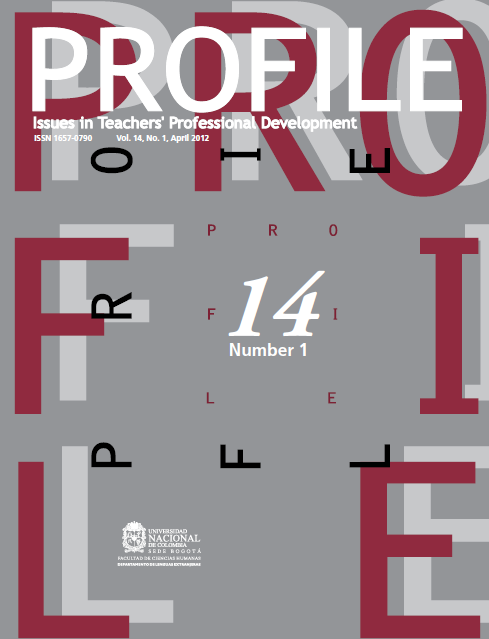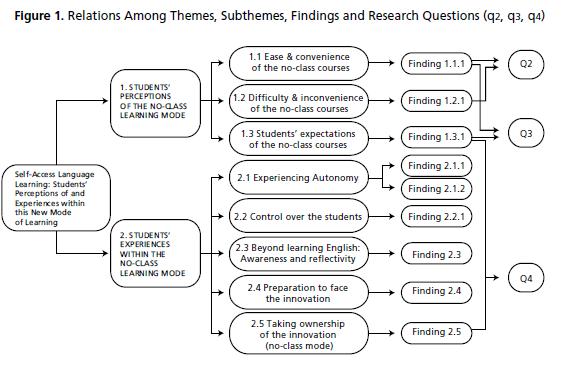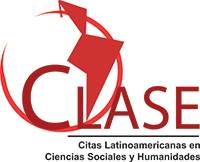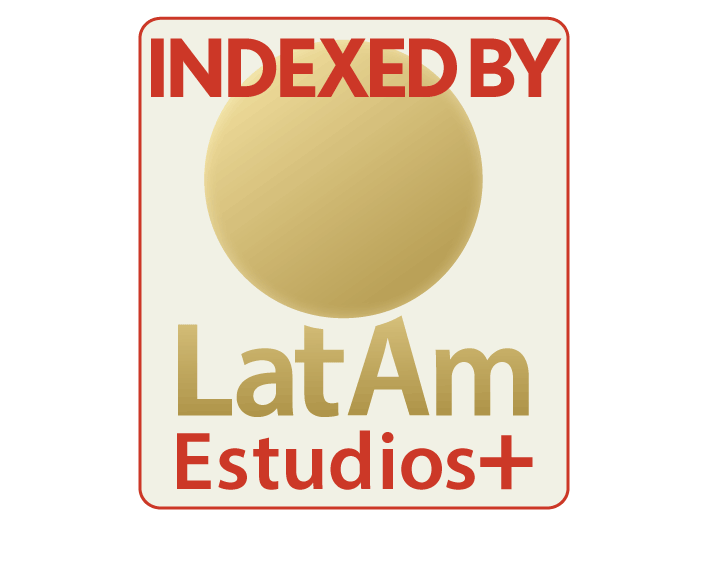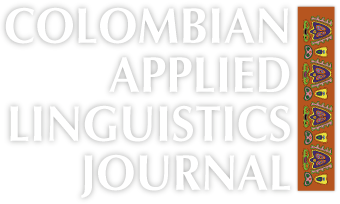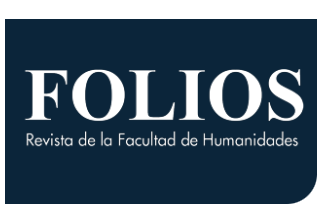Self-Access Language Learning: Students’ Perceptions of and Experiences Within this New Mode of Learning
Keywords:
Autonomous learning, self-access centre, self-access language learning. (en)With the aim of fostering autonomy in learning, both innovations, the self-access centre and the mode of learning derived from it, were adopted in the context of the study (Language Centre in the University of Veracruz, Mexico). Based on a case study, I have adopted a qualitative perspective to do this research, which aimed to know how the students undergoing this new English learning mode perceived it and what their experiences were within the no-class courses. The purpose of this article is to present the main themes that emerged after gathering the data for this study. It concludes with suggestions for a more contextualized and critical adoption of innovations in the English as a Foreign Language arena.
En el contexto de este estudio (Centro de Idiomas de la Universidad Veracruzana, México), y con la finalidad de promover la autonomía en el aprendizaje, se adoptaron dos innovaciones: los centros de autoacceso y el aprendizaje de lenguas en ellos. Basándome en una investigación realizada con el fin de conocer cómo perciben y experimentan los estudiantes esta nueva modalidad de aprendizaje de inglés, el propósito del presente artículo es mostrar los principales temas que surgieron a partir de la colecta de datos. El estudio concluye con la sugerencia de que la adopción de innovaciones en el terreno de la enseñanza de inglés como lengua extranjera se haga de manera más contextualizada y sea más crítica.
Self-Access Language Learning: Students' Perceptions
of and Experiences Within this New Mode of Learning
Aprendizaje de idiomas mediante la modalidad de autoacceso:
percepciones y experiencias de los estudiantes
Luz Edith Herrera Díaz
Universidad Veracruzana, Veracruz, Mexico
ehd63@hotmail.com
This article was received on July 1, 2011, and accepted on December 18, 2011.
With the aim of fostering autonomy in learning, both innovations, the self-access centre and the mode of learning derived from it, were adopted in the context of the study (Language Centre in the University of Veracruz, Mexico). Based on a case study, I have adopted a qualitative perspective to do this research, which aimed to know how the students undergoing this new English learning mode perceived it and what their experiences were within the no-class courses. The purpose of this article is to present the main themes that emerged after gathering the data for this study. It concludes with suggestions for a more contextualized and critical adoption of innovations in the English as a Foreign Language arena.
Key words: Autonomous learning, self-access centre, self-access language learning.
En el contexto de este estudio (Centro de Idiomas de la Universidad Veracruzana, México), y con la finalidad de promover la autonomía en el aprendizaje, se adoptaron dos innovaciones: los centros de autoacceso y el aprendizaje de lenguas en ellos. Basándome en una investigación realizada con el fin de conocer cómo perciben y experimentan los estudiantes esta nueva modalidad de aprendizaje de inglés, el propósito del presente artículo es mostrar los principales temas que surgieron a partir de la colecta de datos. El estudio concluye con la sugerencia de que la adopción de innovaciones en el terreno de la enseñanza de inglés como lengua extranjera se haga de manera más contextualizada y sea más crítica.
Palabras clave: aprendizaje autónomo, aprendizaje de lenguas por autoacceso, centro de autoacceso.
Introduction
The topic of learner autonomy has been the foundation for the promotion and implementation of self-instruction and/or self-direction as modes of learning foreign languages; hence, we note the presence of Self-access Centres (SAC) as a resource for achieving this kind of learning around the world. Mexico, as part of this globalized world, has invested a great amount of time and money establishing several self-access centres all over the country, mostly at public universities, including the University of Veracruz (UV).
While working as a counsellor at the Self-access Centre-Veracruz, at the University of Veracruz (in Mexico), I found that my constant contact with students who were trying to learn English by means of a self-access language learning (SALL) mode led me to reflect on several issues which became the research questions that I endeavoured to answer through the current study:
Research Questions:
1. Are the new "autonomous courses" (based on principles of self-direction and SALL) functioning according to the university's plans for them?
2. How do students studying English as a foreign language perceive the self-instruction mode?
3. What is the difference in perceptions between students who chose to study by this mode and those who had to do it?
4. What are the students' experiences within this innovation -the self-instruction mode of learning and the use of the Self-access Centre?
The following section summarises the context in which this research was carried out. Then, I explain core concepts related to self-access language learning in which through the use of selfaccess centres, autonomous learning is supposed to be promoted. The methodologies I drew on for collecting data and for their analysis -both derived from the qualitative perspective of this study- are illustrated too. Based on the findings, the themes that emerged, I was able to answer the research questions that guided the study. Finally, the implications of the outcomes in the EFL world and the conclusions I reached are presented.
Context of the Study
The current research was carried out at the Language Centre-Veracruz (in Veracruz City), specifically in its Self-Access Centre (SAC) (called CADI= Centro de Autoacceso de Idiomas), at the University of Veracruz (UV), the public university in the State of Veracruz, Mexico.
The University of Veracruz has a student population of approximately 70 thousand pupils distributed among the five campuses. Some of them come from small towns or villages around the city where their campus is located; and most of them are part of middle-class or working-class families. The academic staff totals 6,300 employees. The administrative staff numbers 4,436 employees. Whereas at the Language Centre-Veracruz, the number of students is around 3 thousand and the staff makes up a total of 10 administrative employees and 40 language teachers; 6 of these teachers work as counsellors and there are 2 assistants and 1 technician at each CADI -the CADI in the Language Centre and the CADI in the USBI (the university library called Unidad de Servicios Bibliotecarios y de Informática).
All the Language Centres (Xalapa, Veracruz, Córdoba, Orizaba, Poza Rica/Tuxpan and Coa-tzacoalcos/Minatitlan) offer English and French courses and some of them offer courses of other foreign languages such as Italian, German, Portuguese, Chinese and Japanese. As part of a National Project, four Self-access Centres (CADIs) were opened in 1999 and at present there are nine CADIs working throughout the state of Veracruz. They were all created sharing the same theoretical foundations and aims. They all have the same type of physical structure and facilities (furniture, electronic devices, working areas), but they may have different materials, organization and even a different approach to counselling students. These CADIs are used by people studying any foreign language at the Language Centres and they may or may not be university students ("external students"). Furthermore, the Centres are mostly used by students who are studying English 1 and 2, compulsory subjects in all undergraduate programs, and especially by those who take these subjects in the "autonomous" courses. In these courses, students work by themselves at the CADI, not because they want to but because they do not have any other choice (no place for them in regular classes or attending the CADI is a compulsory part of their course).
Notions on Autonomous Learning and Self-Access
Autonomy and Autonomous Learning
Based on what I already understand as autonomy, I recognize it as the counter-edge, the opposite of traditional-dependence in the learning continuum.
A general meaning of this term would be this one: the condition of something that does not depend on anything else. It is defined as "the quality or state of being self-governing; the right of selfgovernment; self-directing freedom and especially moral independence" (Longman Dictionary, 2005).
The history of the term, in the field of education and language learning, can be traced to the post-WW II period when social rights movements arose and education started to be considered an empowering tool which moved to an awareness of its worth. Collins and Hammond (1991) confirm the latter by saying that "the ultimate purpose of education is the betterment of society, and that critical awareness and social action to promote emancipation are desirable results of any educational intervention" (p. 13).
From the 70's on, there have been several innovations in adult education. Some of them were based on issues such as social awareness and resulted in the insistence of "the need to develop the individual's freedom by developing those abilities which will enable him to act more responsibly in running the affairs of the society in which he lives" (Holec, 1981, p. 1). Others, based on pedagogical issues, maintain that
adults demonstrably learn more, and more effectively, when they are consulted about dimensions such as the pace, sequence, mode of instruction and even the content of what they are studying. (Candy, 1988, p. 75)
In foreign language education, learner autonomy has become, as Little (1991) says, the new "buzz-word" which has transformed old practices in the language classroom and has given rise to self access facilities around the world. The following is one of the most popular definitions: According to Henri Holec (1981), autonomy is an acquired ability to take charge of one's own learning. That is to say,
to have, and to hold, the responsibility for all the decisions concerning all aspects of this learning, ie: determining the objectives; defining the contents and progressions; selecting methods and techniques to be used; monitoring the procedure of acquisition properly speaking (rhythm, time, place, etc); evaluating what has been acquired. (p. 3)
Dickinson (1987) also described autonomy as "a situation in which the learner is totally responsible for all the decisions concerned with his (or her) learning and the implementation of those decisions" (p. 18). Little (1991), still using the idea of capacity, added critical reflection and elements, stating that
autonomy is a capacity -for detachment, critical reflection, decision-making, and independent action. It presupposes, but also entails, that the learner will develop a particular kind of psychological relation to the process and content of his learning. (p. 4)
Another author for whom ability plays a crucial role in the conceptualization of autonomy is Nunan (1995), who states that learners who are able to define their own goals and to create their own learning opportunities have become autonomous.
I prefer to consider Sionis' (1990) description of autonomy. He says that reaching autonomy is a complex process that includes the identification of our own needs, the self-determination of goals and the election and putting into practice of the most suitable learning method as well as a self-evaluation procedure.
Among the diverse conceptualizations of autonomy that have arisen in the ELT milieu is Benson's who describes it as the acknowledgement of the rights of learners within educational systems (1997), which takes into consideration the fact that "the self-directed learner may choose classroom instruction" (Dickinson, 1987, p. 11). This position is also consistent with Pennycook's (1997) claim that there might be students "who independently [choose] to come to a teacher to learn and would prefer that teacher to teach in a 'teacherly' way" (p. 43). Both statements sound so fair that I find them rather far from reality in the educational setting where I carried out this piece of research (CADI-Veracruz). There, some students have no option but to take their English course(s) in the no-class mode, which is incongruously called "autonomous mode" (no-class mode and no-class students are terms which I created as a result of my inquiry in the actual field of this study). However, I still think that even in this case students may be able to reach, or rather, exercise some degree of autonomy, understood as Boud (1998) and Cotterall (2003) describe it in the following paragraph.
Boud (1988) comments that "[t]he main characteristic of autonomy as an approach to learning is that students take some significant responsibility for their own learning over and above responding to instruction" (p. 23, my italics) while Cotterall (2003) recognises that in several contexts many opportunities are given for "the learners to assume control of some of the decisions surrounding their learning" (p. 1, my italics).
Self-direction and Self-instruction
Regarding the concepts of self-direction and self-instruction, Dickinson (1987) explains the former as an attitude because that has more to do with a personal decision, although he keeps on talking about "all the decisions" when he states that self-direction
describes a particular attitude to the learning task, where the learner accepts responsibility for all the decisions concerned with his learning but does not necessarily undertake the implementation of those decisions. (p. 12, my italics)
Along the same line of thought, Nunan and Lamb (1996) suggest that at the end of the day it is the learner and only the learner who has to do the learning, and that every kind of educational act should lead learners towards self-directed learning. However, I consider, as Dickinson (1987) aptly comments, that only a very few people are naturally self-directed and that many learners who turn to self-instruction do it for their own convenience and not because it appeals to them. He suggests that
[i]t is not desirable to thrust self-instruction and self-directed learning on to learners who are resistant to it, and it is very important (...) not [to] confuse the idea, or our enthusiasm to introduce it, with the learner's ability or willingness to undertake it. (p. 2)
Regarding the concept of "self-instruction", Dickinson (1987) defines it as a neutral term which refers to
situations in which a learner, with others, or alone, is working without the direct control of a teacher (...) [either] for short periods within a lesson, for whole lessons, or in the extreme case of learner autonomy, where he undertakes the whole of his learning without the help of a teacher. (p. 5, my italics)
The same author talks about homework as an old example of a self-instruction activity. In my view, self-instruction (as defined above) would be the most feasible type in my context. And as I experienced it as a counsellor at CADI-Ver, it is the mode of learning that prevails there, although we insist on calling it "autonomous learning" just because the students do not attend regular classes.
Self-Access Centres and SALL (Self-Access Language Learning)
In general, the term self-access refers to the organization of learning materials and equipment made available and accessible to students without necessarily having a teacher present. In Sturtridge's words (1992), the term self-access centre refers to the "system which makes materials available to language learners so that they can choose to work as they wish, usually without a teacher or with very limited teacher support" (p. 4).
Several authors talk in a similar way about self-access centres as the area in which specially designed, adapted or processed materials can be used by learners in such a way that they can direct and assess their own learning with or without help (Sheerin, 1989; Booton & Benson, 1996; McCafferty, n.d.; Dickinson, 1993). Looking at the background of self-access centres, I feel it can be said that their predecessors are the language laboratories that responded to a behaviouristic, lock-step approach to language learning. However, even though they recognise their differences, Gremmo and Riley (1995) would rather compare SACs to libraries, since these were a basic manifestation of autonomous and self-directed learning.
The implementation of a SAC depends basically on "the beliefs about learning which are held by those who set up the system" (Sturtridge, 1992, p. 4). Therefore, depending on this ideology, the needs perceived and the teaching situation to which it is related, a SAC may function as an instruction centre; as a practice centre; as a skill centre or as a learning centre, all of them sharing the characteristic of fostering autonomy and the skills of self-directed learning (Booton & Benson, 1996).
Derived from self-access centres, the term self-access language learning (SALL) stands for the kind of learning that takes place precisely in a SAC. Sheerin (1989) says that "[t]he essential prerequisite to self-access learning is the provision of self-access materials within an organized framework so that students can get what they need" (p. 7).
SALL seems to arouse controversy in two aspects: the cost-efficiency and the development of autonomy. Regarding the former, there are authors (e.g. Aston, 1993) who see this mode of learning as a cost-saving proposition, which eventually could substitute for direct teaching. Whereas others like Gardner and Miller (1997) think that
[i]mplementing SALL should not be seen as a cheap alternative to teaching. It should be seen as a useful complement to teaching which enhances language-learning opportunities and provides learners with the independent learning skills to continue learning languages after they have finished formal studies. In this light it may be judged to be relatively cost efficient. (p. 32)
Regarding the latter, it is known that although this mode of learning is supposed to promote learners' autonomy, it does not necessarily occur. Students may be working by themselves in a SAC but still doing what their teachers told them to do (Reinders, 2000). That is to say, "a self-access centre could be used as a teacher-directed source of individualised homework activities, but this would in no way constitute self-directed learning" (Sheerin, 1994, p. 144). In any case, there are positive positions/perspectives towards SALL. Even if it is not undertaken with the aim of becoming autonomous learners,
[s]elf-access learning is the practical solution to many language teaching problems: mixed-ability classes, students with different backgrounds and needs, psychological and personality differences between students, etc. (Sheerin, 1989, p. 7)
I think the latter is as true as Gardner and Miller's view of SALL as a mode of learning that offers varying degrees of guidance but still encourages students to move towards autonomy (1997). The achievement of such autonomy, in my view, will not depend on the mode of learning itself, nor on the SAC where students may work, but on their attitudes, their decisions and the education system in which they may be immersed.
Method
Considering that I was not aiming to "measure" anything but to study the events in their natural setting, to attempt to understand students' perceptions and to make sense of or to construe their experiences in the specific context where they evolve, I decided to adopt a qualitative mode of research.
Qualitative research attempts to look deeply into the quality of the social life in particular settings, permits the exploration of the important themes that may emerge, those mysteries of reality "to which the researcher must submit, and can do no more than interpret" (Holliday, 2002, p. 6). It studies small and/or particular groups of human actors in natural settings, in their everyday world, in a particular time. According to Denzin and Lincoln (2000, p. 3), qualitative research is a situated activity that locates the researcher in the world with an interpretive, naturalistic approach towards it. In a similar way, Maykut and Morehouse (1994) describe qualitative research as that which
looks to understanding a situation as it is constructed by the participants (...) [it] attempts to capture what people say and do, that is, the products of how people interpret the world. (p. 18)
Qualitative inquiry then, seeks to understand the meanings and significance of certain humans' actions from their own perspective (Lankshear & Knobel, 2004; Maykut & Morehouse, 1994; Richards, 2003; Robson, 2002), which is done by employing a range of methods and analyses based on a range of features. As Denzin and Lincoln (1994) put it,
[q]ualitative research is multimethod in focus, involving an interpretive, naturalistic approach to its subject matter (...) [it] involves the studied use and collection of a variety of empirical materials -case study, personal experience, introspective, life story, interview, observational, historical, interactional, and visual texts- that describe routine and problematic moments and meanings in individuals' lives. (p. 2)
Process of the Data Collection
In this research, treated as a case study, I used some data collection methods which are commonly used in ethnographic research, namely: moderate participant observation (c.f. Cherulnik, 2001; DeWalt & DeWalt, 2002; Patton, 2002) and semi structured interviews (c.f. DeWalt & De Walt, 2002).
As planned, I was able to observe the different areas (Video, Audio, Computers, Multiple Uses, etc.) in which CADIs are divided while students were working there, as well as several counselling sessions coordinated by counsellors in whose groups the participants (interviewees) were enrolled.
The data collection phase took place at CADI-Ver, where I work as a counsellor. I interviewed seventeen university students who were taking English 1 and 2, as well as two who had already finished, and two external students who were studying EFL at the Language Centre. These interviews were conducted in Spanish and I translated the extracts presented here. I also interviewed, in English, four of the counsellors working there and the Coordinator of the Language Centre, who had been a counsellor at the CADI.
Furthermore, I looked at the students' monthly work reports that were processed on the computers located at the Check in/out Area of the CADI-Ver. These reports contained information related to the worksheets or materials they worked on, the time they spent at the CADI and a self-evaluation of the session. I decided to consider these documents as another piece of data because as Robson (2002) mentions, written documents are not affected by the act of being used. I wanted to use the information obtained by this means to complement, as far as possible, the information I was able to gather through the interviews and observations.
Process of the Data Analysis
In this section I succinctly describe the themes and sub-themes that were uncovered throughout the processing of the data. For this analysis I adopted and adapted some elements from procedures such as the constant comparative method (Lincoln & Guba, 1985 based on Glaser & Strauss, 1967; Maykut & Morehouse, 1994); the concepts/ coding method suggested by Coffey and Atkinson (1996), and the approach suggested by Miles and Huberman (1994) because they suited my analysis of data during the data collection stage as well as later on when I had already collected all the data.
The actual process of my data analysis consisted of the following stages:
- Organising the data (45 interviews and 29 observations/field-notes)
- Coding the data materials
- Highlighting the data materials
- Reviewing the data materials
- Summarizing the data
- Labelling the data: first-level codes
- Labelling the data: second-level codes
- Inventorying the data
- Grouping the codes (first/second-level)
- Displaying the data (in a Matrix)
- Naming categories (preliminary, sub-, and categories)
- Refining categories, uncovering themes
- Designating hierarchies to the categories
- Moving towards interpretation
- Summarizing the data analysis procedures.
Findings and Revisiting the Research Questions
This section illustrates nine out of the thirteen findings of the study. For those I consider the most relevant, I present samples of evidence from the data that underlie these findings. As shown in Figure 1, the topic of the study is divided into two broad themes, which are divided into the subthemes that emerged from the data and which the findings are related to. At the same time, the findings are related to the research questions (see the Introduction section) to which I consider they are responding.
Since the findings presented here are related to the eight subthemes shown in Figure 1, the former are numbered according to the corresponding subtheme. As mentioned before, extracts from the data referring to the main findings are included here for a deeper understanding of the themes under consideration. The other findings are mentioned also so as to give a complete idea of what was found out throughout the study.
1. Students' Perceptions of the No-Class Learning Mode
1.1 Ease and Convenience of the No-Class Courses
Here, I refer to the students' idea that this learning mode would be, or rather was, easy and practical in terms of time/schedules, particularly with respect to the other subjects (of their respective majors) and of some of the characteristics of the courses, as the following student declared:
I wish it had been easier, last semester [English 1] wasn't hard at all, but this one [English 2] is more complicated... I must work harder... but for me it's very practical, because I take many subjects and my schedules are crazy, so for me it's very practical... in the autonomous [courses] the advantage is that it's only 1 hour a week and one can determine how long and when one can come during the week.
Counsellors also agreed; they had observed or heard that students expected this kind of course to be easy, practical and convenient. In this respect one of them commented:
Some of them let me know that they thought it was a lot easier, because in their faculties they said 'oh you just have to go once a week, so you don't have to worry about it'... but it's not just a matter of coming once a week, well... although this is comfortable for them.
The passages above seem to indicate what finding 1.1.1 summarizes: Most students seemed to have recognized the value of the no-class courses based on the convenience and easiness (regarding the management of their time and schedules) that they attributed to these courses, rather than on their contribution to their learning English or on the features of this type of courses.
1.2 Difficulty and Inconvenience of the No-Class Courses
Among the most common problems that students mentioned when giving their opinions about the no-class courses was how difficult it was for them when they had to commute from their schools to the Language Centre or to the USBI where the CADIs are located and where the counselling sessions took place. Two of the students stated this:
The idea [to work in the self access centre] is good, but the distance from our schools was not considered... mmm yes, CADI is far from my school (...) I don't have time to come because of the distance, and I couldn't make [accumulate] enough hours of work.
The course is good but the defect is... that it isn't well organized according to our major's program, (...) they are too many subjects, and, and the location of my school is too far, and the time...more than anything is the time (...) [I'm] in Administration, there in the north, and there isn't a direct bus, you have to take 2 or walk a lot... imagine!!! We need around 3 hours to come to CADI, and our other classes?
Another problem that several students remarked on was the difficulty they had when studying without the constant presence of a teacher; this is an example of what they said:
Working by myself was hard because I didn't know any English, you see!! (...)... ufff, studying by myself is very difficult because there is no teacher to tell me everything and to teach me, especially the pronunciation... mmm it's very difficult, very difficult and the exam is coming!!
Counsellors also perceived the difficulty that students had when studying without a teacher and two of them commented:
Definitely, students in basic levels cannot cope with the idea of working by themselves, it's hard, hard (...) But, but Language Centre students do better.
Well... it's obvious that students who are forced to take the autonomous, and mmmm... it's the majority, see?, they have more difficulties to adapt to this mode (...) yes, students need somebody to guide them... they look for it!!
It seems, as Toogood and Pemberton (2002) identified, that the students still needed some structured support since we were dealing with students who had been "socialized into seeing teachers as the directors of the learning process rather than advisers..." (p. 9).
In brief, finding 1.2.1 refers to the no-class courses' lack of planning, especially in terms of the location of the buildings involved, the programs, the students' interests, the students' preparation for the change and the relevance of the subject (EFL), was a significant reason behind their difficult and slow '"routinization" and the scarce development of autonomy.
1.3 Students' Expectations from the No-Class Courses
According to the information provided by the students in the interviews, they got to the courses with certain expectations (work by themselves, attend only once a week, many materials and counsellors/teachers available, easy contents, no rules). I considered it important to ask them to what extent those expectations had been fulfilled or agreed with what they had actually got during the courses and how they felt about it. Several students talked positively in this respect, for instance:
I already had the idea that I had to work by myself, that I was going to learn as much as I wanted; that I had to attend the counselling sessions to solve some doubts, but the one who would learn was I myself, not because I had to attend an everyday class... and it [the development of the course] is just as I thought!!
mmm... more than anything I didn't expect a counselling session at CADI but something like tools to reinforce my knowledge, and it has been accomplished for example with the audio system, the computers and all the materials that we can find here, it has been as I expected.
Some counsellors talked about both the Language Centre students and the MEIF students saying the following:
Language Centre students, aha... they usually fulfil their expectations, they are satisfied with what they're doing, some of the students prefer to continue working as autonomous because they like it better, specially adults... MEIF students... mmm... only the ones who study hard and really want to learn.
Despite the advantages that students recognized as regards these courses, they also thought that the contents of the course were more difficult than they had expected and that there were requirements and rules to comply with that they did not expect to have. Furthermore, some students felt they had not obtained what they had conceived and thus expressed some disappointment, as shown in these passages:
(Smiling) What I got?... headaches... hehehe! (laughs)... I feel that my progress was average, no?, I am not going to question that there is some learning because at the beginning I thought it was not going to work for me, certainly it worked.
From this course I didn't get a big thing sincerely, it was only a review, a reminder of what I had already seen [learnt], the only thing l liked was its schedule flexibility (...) but that it was useful, or I had learnt much... no, unfortunately no, because it was only a review.
Through the interviews it was noticeable that most students, whether they were pleased with their "autonomous" courses or not, whether their expectations had been fulfilled or not, but especially the ones whose expectations had not been fulfilled, expressed their preference for classes. The following are samples of this:
At the beginning I thought it was not going to work for me, but it certainly worked, but it's not the same, I would've preferred to have a class with a teacher and classmates, because the counselling session... ehhmm... didn't help me much... don't tell the teacher eh! [secretly, in very low voice]
Yes, I really think that I would take the other course in a class,... it's not a criticism of the course, but actually... it's not the same, one gives it more priority or... one takes it more seriously in a class, that is, I have the English class at certain time, it's not like: let's see when I'm going to make hours [clock up hours] of English... it's different, mmm.
Capturing the excerpts above, finding 1.3.1 states: The no-class mode of studying EFL failed to meet several of the students' expectations, and this had a significant impact on their perception of the whole project, resulting in their partial acceptance of this mode and their preference for the class mode.
2. Students' Experiences within No-Class Learning Mode
2.1 Experiencing Autonomy
I also found that some of the students involved in this study had a clearer idea of what autonomy meant in this context and expressed their exercise of it, as can be read in the following quotations:
The tools are there and one knows if we use them and what time, how long and how to use them according to your own capacities. If I organize myself I can do the things by myself (...) for me it's easier because I know myself, I know my moments, I know how to organize myself (...) and for me it's easier to take it in this mode than depending on a fixed schedule or on other people.
In a class, it's ok, but there are things that if you have already understood... why to see them again? Preferably, you move forward to whatever you want, audio, vocabulary or video; or if there is something that you don't remember very well, you go back to it and review it (...) It depends only on you!
My field-notes below also demonstrate the exercise of autonomy in a very productive way:
Field note at the Check In/Out Area-CI: A girl checks in, looks for an audio-book, asks for the tape to the assistant and finds a place to seat. It seems she has previously decided what to do, what materials to work on.
Field note at the Listening Area-USBI: One of the girls who has been working very focused, writes on her log, turns off the tape recorder, gives back the tape and changes to another area (Multiple Uses Area). The girl next to her does the same. They start working with other materials.
However, there were some students who did not have this attitude, such as the ones mentioned by this counsellor:
They usually do grammar, grammar and grammar. In fact they like that they can do and practice whatever they want, well... when they want!! (...) Some students are reluctant to work, they just don't want to do anything, they don't care.
My observations also registered how the students came to this kind of decisions, even at the expense of not getting credits for their participation in the counselling sessions or for their work at the CADI, as reported in the following field-notes:
Field note in a Counselling Session: One boy is drawing on a piece of paper, well he's signing, like practicing his signature, I thought he was taking notes... maybe he's decided not to pay attention!. (...) Other boy is also drawing on a piece of paper; when the counsellor asks if they have any doubts one of them asks her about the lists for the final exams (...) Even when the boys are not looking at her but drawing, it seems they pretend to be paying attention.
Field note at the Video Area-USBI: Two girls sit next to each other, start playing the videos and start talking, they put on the earphones but only in one ear so that they can keep on chatting; they pretend they're watching the video and writing or rather looking at the worksheet, but they are chatting (whispering) all the time. However other students seem to be working they watch attentively, rewind the videotapes and write on their worksheets.
Considering the previous excerpts, I agree with Marsh et al (2001) when, after researching this topic among undergraduate students at Nottingham Trent University, they commented that,
[n]otions of autonomy and independence have no objective existence for students in their lived world. Yet the terms feature strongly in the teaching and learning discourse with which students have to engage. [Thus, for] many students, the terms are reducible to attendance requirements, that is, something about doing, rather than being. (p. 387)
There was another counsellor's noteworthy opinion related to the absence of autonomy in some students' everyday performance within their no-class courses. This counsellor commented:
But it's natural, no?... look, when children are in Kindergarten they are free, they can play and do many things they want, very nice; then, in Primary school... there you are... orders, prohibitions, 'you have to memorize this and that'; in High school -worse, no?- you have to study many different subjects, there are a lot of contents, homework and rules and more rules to observe, finally, you get to the University and suddenly in English [courses]... well, now you are autonomous!! and you go 'what's that'? It's a shock for the students.
What the new mode meant to some students, that is, the difficulty it represented for them to study without taking classes and without having a teacher at hand constantly, is expressed in the following findings:
Regarding finding 2.1.1, some students were able to achieve some degree of autonomy. It should be noted that autonomy" in this context seems to refer to actions such as choosing when, how long and what to work on at the CADI; deciding to actually work or to pretend to be working in order to accumulate credits; determining their attendance and participation in the counselling sessions; and trying their best to pass the subject.
Finding 2.1.2 indicates some of the possible causes for students' failing to carry out the no-class courses. They might be as follows: their resistance to the imposition of the innovation; their misinterpretation of the notions of autonomy as used in the educational setting, or their identification of the mismatch between the "discourse of the new mode of studying" and their experience as students in an institutional context.
2.2 Control over Students
It is worth noting that in a system which claimed to be based on the notion of autonomy and whose name was in fact "autonomous mode", the exercise of control and surveillance was more palpable and more open to criticism.
Examples of this control can be described through these students' statements:
I became more responsible because they put pressure on us, I mean they force you to study and to study the basic things... what they are going to ask you [in the exams].
It [the CADI and the no-class mode] is like a father with a belt in his hand telling you to do the things.
I feel uncomfortable with this issue of being asked to do certain number of hours or activities... and the counselling sessions, well... they're ok, they are useful to have control on what students have to study.
As can be noticed in the excerpts above, some students mentioned the subtle coercion they felt they were subjected to. This idea was also manifest when some of the counsellors declared:
We have decided not to check more hours, now we are more interested in the activities they have done during the week.
One of our duties is to check if they [the students] have worked and what [activities and areas] they have done during the week.
I want to complement these indications of control with some of the numerous notes of my observations, either of the areas at the self-access centre (CADI) or of the counselling sessions in which the practice of subtle control and surveillance over the students was noted:
Field note at the Computers Area:... all the students in this and in all the areas, especially in the Check in/out Area, write on their logs, they are supposed to write down the key of the worksheet they have done and the time they've been there.
Field note at the Check in/out Area-USBI: The assistant stamps a student's log, and when she's about to give her bag back to the girl, she suggests her to do another activity to complete the time, since the computer doesn't register less than 30 min.
Field note in 4 different Counselling Sessions of levels 1, 2, 3 and 5: In every single counselling session the students' logs are checked; counsellors ask the students to pass their logs to them, then they write down on their lists in order to keep a record of whatever the students have done at CADI. There are counsellors who spend so long in this issue, and they scold or give suggestions to the students based on these logs... it's incredible how important the logs are in this system!!!
According to the preceding quotations, whether the students were to complete a certain number of activities instead of hours or to cover different areas (e.g. vocabulary, grammar, video, audio, etc.), it seemed that it was pre-established by someone else but the students as it occurs in the self-instruction mode, but contradicting again the original conception of autonomy.
Another account of the surveillance taking place in the setting of this study can be read in the following extracts of my field-notes:
Field note at the Multiple Uses Area-USBI: The assistants are working on the computers; suddenly one of them starts walking around the CADI just to see what the students are doing... they must be working quietly???
Field note at the Multiple Uses Area-USBI: (...) the other 3 friends are still joking and laughing; suddenly the assistant walks in and everybody stays still, nobody talks except one of the boys who is so distracted fooling around, but his friend touches him with a pencil and then he realizes that the assistant is there. She walks straight to those 3 boys and asks them to be quiet; she tells them that she will subtract 15 minutes to their times because they haven't been doing anything but playing.
These excerpts seem to illustrate how the assistants (although it could also be the counsellors or even the technicians) oversaw the students and tried to control their discipline by scolding them and by reducing their allotted study time from their records. It must be mentioned that these surveillance actions seemed to be facilitated by the construction and arrangement of the CADI buildings where the rooms (areas and offices) were divided by short walls (1 meter tall) containing huge windows through which the counsellors and assistants were able to constantly keep an eye on the students who were in the areas. Due to the accessibility of the view of the areas and the people there, who hardly noticed they were being watched, this "functional" architecture recalls the conception of Jeremy Bentham's prison "in which prisoners supposed that they were under the all-seeing gaze of an inspector" (Lyon, 2001, p. 7) who was in a central tower from which he was able to watch all the prisoners in their cells that surrounded the tower but without being noticed. Even if the prisoners were not being watched, they watched themselves and functioned within the norms.
Recapitulating the samples of data presented here, finding 2.2.1 states the following: Contrary to the claim that the no-class mode was based on and fostered principles of autonomy and independence, important factors which suggested that surveillance and control were subtly exerted over the students in the no-class mode were revealed.
As mentioned above, besides the six major findings already discussed, three other findings are briefly described below in order to offer an overall panorama of the study.
2.3 Beyond Learning English: Awareness and Reflectivity
Despite the difficulties faced by some students undergoing this new mode of learning EFL, there seemed to be a significant enhancement of some students' capacity for making decisions and evaluations, and for developing reflectivity and awareness of their own learning processes and of their situation as university students throughout their no-class courses.
2.4 Preparation to Face the Innovation
A substantial output of the research suggested that significant problems in the no-class courses were the stakeholders' lack of preparation to embark on the innovation, their reluctance to use the CADI materials, which could have been of help in this preparation, and the scarce effectiveness of the introductory course.
2.5 Taking Ownership of the Innovation (No-Class Mode)
An unexpected result was that most of the stakeholders -the counsellors as well as the students- seemed to be taking ownership of the innovation by gaining knowledge and experience, by participating in the system's development, and the students, especially, by doing what they considered appropriate and convenient for them, which was mostly related to issues of time and credits.
Conclusions
According to the outcomes of the current study may I suggest that the "autonomous mode" of learning/teaching foreign languages (especially EFL) has been institutionalized in such a way that it turned out to be suitable to the educational system in general and to the university's system in particular, in spite of its divergence with the promotion of "autonomy" and the lack of consideration of the local context. For this reason, I consider that the university should do local needs' analyses, evaluations of the actual development of the no-class system (autonomous courses and SACs) and by interweaving them, they should redesign and make them more suitable to the local conditions and more congruent with their principles (finding 4). In this new design, maybe other foreign languages and modes of teaching/learning would have to be included in the schema (finding 1).
To conclude and as an attempt to answer the Research Question 1 (Q1), I can say that, based on the concepts that have been reviewed here (autonomy, self-instruction, self-access language learning, self-access centres) and on the outcomes from this research, what the Language Centre-Veracruz, and perhaps many other language centres around México (c.f. Clemente, 1998), has offered as "autonomous courses", based on principles of self-direction, SALL and critical thinking, are in fact "no-class courses". These courses, contrary to what autonomy implies, exercise a subtle control and surveillance over the students (finding 2.2.1) rather than promoting autonomy. I consider that a reappraisal and the consequent reorientation of the project (the no-class system) are necessary actions to be taken during the "routinizing" stage the system is going through, so that it fosters the students' learning and independence.
References
Aston, G. (1993). The learner's contribution to the selfaccess centre. ELT Journal, 47(3), 219-227.
Benson, P. (1997). The philosophy and politics of learner autonomy. In P. Benson, & P. Voller (Eds.), Autonomy and independence in language learning (pp. 18-34). Harlow: Longman.
Booton, P., & Benson, P. (1996). Self-access. Classification and retrieval. Britain: The British Council.
Boud, D. (Ed.). (1988). Developing student autonomy in learning (2nd ed.). New York, NY: Kogan Page.
Candy, P. (1988). On the attainment of subject-matter autonomy. In D. Boud (Ed.), Developing Student Autonomy in Learning (2nd ed.) (pp. 17-38). New York, NY: Kogan Page.
Cherulnik, P. (2001). Methods for behavioural research: A systematic approach, Thousand Oaks, CA: Sage.
Clemente, A. (1998). SLA Research on self-direction: Theoretical and practical issues, PhD Thesis, Institute of Education, University of London, UK.
Coffey, A., & Atkinson, P. (1996). Making sense of qualitative data. London: Sage Publications.
Collins, R., & Hammond, M. (1991). Self-directed learning. Critical practice. London: Kogan Page.
Cotterall, S. (2003). Learner Independence: reflecting on experience. Paper presented at the Independent Learning Conference 2003, University of Melbourne September 13-14, 2003. Auckland. Keynote address. Retrieved from http:/www.independent learning.org/ila03/ila03
Glaser, B. G., & Strauss, A. L. (1967). The discovery of grounded theory: Strategies for qualitative research. Chicago: Aldine Publishing Company.
Denzin, N., & Lincoln, Y. (Eds.). (1994). Handbook of qualitative research. Thousand Oaks, CA: Sage.
Denzin, N., & Lincoln, Y. (Eds.). (2000). Handbook of qualitative research (2nd ed.). Thousand Oaks, CA: Sage.
DeWalt, K., & DeWalt, B. (2002). Participant observation, a guide for fieldworkers. New York, NY: Altamira Press.
Dickinson, L. (1987). Self-instruction in language learning. Cambridge: Cambridge University Press.
Dickinson, L. (1993). Self-instruction in language learning. Cambridge: Cambridge University Press.
Gardner, D., & Miller, L. (1997). A study of tertiary level selfaccess facilities in Hong Kong. Hong Kong: ESEP, City University of Hong Kong.
Gremmo, M-J., & Riley, P. (1995). Autonomy, self-direction and self-access in language teaching and learning: The history of an idea. System, 23(2), 151-164.
Holec, H. (1981). Autonomy and foreign language learning. Great Britain: Pergamon.
Holliday, A. (2002). Doing and writing qualitative research. Great Britain: Sage.
Lankshear, C., & Knobel, M. (2004). A handbook for teacher research, from design to implementation. Buckingham: Open University Press.
Lincoln, Y., & Guba, E. (1985). Naturalistic inquiry. Thousand Oaks, CA: Sage.
Little, D. (1991). Learner autonomy 1: Definitions, issues and problems. Dublin: Authentik.
Longman Dictionary of English Languages and Culture (2005). Harlow: Longman.
Lyon, D. (2001). Surveillance society: Monitoring everyday life. Buckingham: Open University Press.
Marsh, C., Richards, K., & Smith, P. (2001). Autonomous learners and the learning society: Systematic perspectives on the practice of teaching in Higher Education, Educational Philosophy and Theory, 33(3 & 4), 381-395.
Maykut, P., & Morehouse, R. (1994). Beginning qualitative research, a philosophic and practical guide. London: Routledge Falmer.
McCafferty, J. (n.d.). A consideration of a self-access approach to the learning of English. London: The British Council.
Miles, M. B., & Huberman, A. M. (1994). Qualitative data analysis: An expanded sourcebook (2nded.). Thousand Oaks, CA: Sage.
Nunan, D. (1995). Closing the Gap between Learning and Instruction. TESOL Quarterly, 29(2), 133-158.
Nunan, D., & Lamb, C. (1996). The self-directed teacher. New York, NY: Cambridge University Press.
Patton, M. Q. (2002). Qualitative research & evaluation methods (3rd ed.). Thousand Oaks, CA: Sage.
Pennycook, A. (1997). Cultural alternatives and autonomy. In P. Benson, & P. Voller, (Eds.), Autonomy and independence in language learning (pp. 35-53). Harlow: Longman.
Richards, K. (2003). Qualitative inquiry in TESOL. Hampshire: Palgrave.
Reinders, H. (2000). A learners' perspective on learner autonomy and self-access language. (Unpublished master's thesis). University of Groningen, the Netherlands.
Robson, C. (2002). Real world research (2nd Ed). London: Blackwell Publishing.
Sheerin, S. (1989). Self-access. Oxford: Oxford University Press.
Sheerin, S. (1994). Self-access. Oxford: Oxford University Press.
Sionis, C. (1990). Let them do our job! Towards autonomy via peer-teaching and task-based exercises. English Teaching Forum, 28(1), 5-9.
Sturtridge, G. (1992). Self-access. Preparation and training. London: The British Council.
Toogood, S., & Pemberton R. (2002). Integrating selfdirected learning into the curriculum: A case study. In P. Benson, & S. Toogood (Eds.), Learner Autonomy 7: Challenges to Research and Practice (pp. 86-110). Ireland: Authentik.
About the Author
Luz Edith Herrera Díaz is the coordinator of the MA TEFL programme at the Language Centre-Veracruz (University of Veracruz, Mexico), where she has been an English teacher and counsellor at its self-access centre. She holds a BEd TESOL, a Masters' degree in Education and a PhD in Language Studies from Canterbury Christ Church University, UK.
How to Cite
APA
ACM
ACS
ABNT
Chicago
Harvard
IEEE
MLA
Turabian
Vancouver
Download Citation
Article abstract page views
Downloads
License
You are authorized to copy and redistribute the material in any medium or format as long as you give appropriate credit to the authors of the articles and to Profile: Issues in Teachers' Professional Development as original source of publication. The use of the material for commercial purposes is not allowed. If you remix, transform, or build upon the material, you may not distribute the modified material.
Authors retain the intellectual property of their manuscripts with the following restriction: first publication is granted to Profile: Issues in Teachers' Professional Development.



